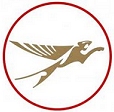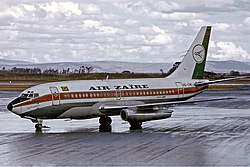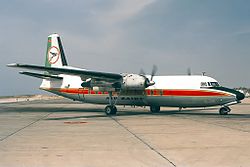Air Zaire
| Air Zaire | |
|---|---|

|
|

|
|
| IATA code : | QC |
| ICAO code : | AZR |
| Call sign : | AIR ZAIRE |
| Founding: | 1961 |
| Operation stopped: | 1995 |
| Seat: |
Kinshasa , Zaire |
| Home airport : | Ndjili Airport |
| Fleet size: | 3 |
| Aims: | National and international |
| Air Zaïre ceased operations in 1995. The information in italics refer to the last status before the end of operation. | |
Air Zaïre was a state-owned company in the Republic of Zaïre (now the Democratic Republic of the Congo ), which ceased operations in June 1995. The international airline was founded in June 1961 under the name Air Congo .
Air Congo
In June 1960, the Belgian colony of the Congo was given independence. Shortly after the founding of the state, plans were made to set up a new national airline, which was to continue operating the national and international routes established by the Belgians from the beginning of 1961. Due to the unstable situation in the country, Air Congo could only be founded on June 6, 1961. In addition to the Republic of the Congo (with 65%), the Belgian airlines Sabena (with 30%) as well as Sobelair and Air Brousse (together with 5%) also had a stake in the new company . Sabena provided the technical and organizational support during the construction phase. Flight operations began on June 28, 1961. Initially, Air Congo served a national route network as well as intra-African routes to Luanda , Ndola , Entebbe , Nairobi and Lagos with aircraft of the types Douglas DC-3 and Douglas DC-4 . In addition, long-haul flights to Brussels were carried out with a Douglas DC-6 .
The company's first jet aircraft was a Boeing 707 leased by Sabena , which from March 1963 was used on two weekly flights to Brussels. A month later joined Air Congo of IATA in. From 1964, smaller airfields were also added to the national route network and approached with Beechcraft Baron , Beechcraft 18 and Cessna 310 machines. In addition, the company also carried out aid flights for the UN . In 1967 the company ended its cooperation with Sabena , after which the Republic of the Congo took over the shares of the three Belgian companies.
After its nationalization, the company invested in more modern aircraft and took over two Sud Aviation Caravelle , which were used on intra-African routes from October 1967. For long-haul flights to Europe rented Air Congo from 1969 two Douglas DC-8 of the US Pan American World Airways ( Pan Am ), which was also charged with the maintenance of the machines and oversaw the company logistically. Air Congo acquired the two leased Douglas DC-8s in 1970 and also ordered two more brand new machines of this type. At the same time, Fokker 27 gradually replaced the older Douglas DC-3 and DC-4 on national routes.
Air Zaire
At the same time as the name of the Republic of the Congo was changed, the company was renamed Air Zaïre on October 25, 1971 . In the early 1970s, the company expanded its European route network and ran the flight to Brussels via Athens , Madrid , Geneva , Paris , Rome and Frankfurt every day . For long-haul flights the company in 1972 ordered two widebody aircraft of the type McDonnell Douglas DC-10 . Due to the bankruptcy of the German Atlantis , Air Zaïre was able to take over a machine from the manufacturer early on June 12, 1973. Until the delivery of the second Douglas DC-10, the company rented a Boeing 747 from Pan Am . In addition, from 1973 three Boeing 737s added to the fleet. In addition to regular liner services and freight transport, the company carried out numerous special flights for the presidential family as well as Mobutu confidants and members of the government. The Faro airport is often driven when Mobutu on his estate in the Algarve stayed and flew in civil servants.
Air Zaïre was a loss-making state company that at times employed up to 6,500 people. In 1984 the bankruptcy of the company could only be prevented by further state financial aid. As a result, the company was imposed a comprehensive savings program, in the implementation of which in 1985 some of the aircraft were sold and all international scheduled connections except for two weekly flights to Brussels were canceled. At the same time the company reduced its staff from 4800 (in 1984) to 2000 employees (in 1986). The state claimed the proceeds from the aircraft sales, so the company's financial situation remained strained. In 1986, a Douglas DC-8 was confiscated in Brussels after dismissed Air Zaïre pilots had sued pending salary claims in Belgian courts. The plane was triggered by the Sabena airline after the state of Zaire threatened to withdraw its landing rights.
On February 1, 1986, the French Union de Transports Aériens ( UTA ) took over the technical and organizational support of Air Zaïre , whose fleet was partially unfit for air at that time due to lack of maintenance . Due to technical flight cancellations and the downsizing of the national route network, the company lost more and more passengers, so that Scibe Airlift became the largest airline in the country. At the end of 1989 the company's fleet consisted of just two Boeing 737s, a Douglas DC-10 and a Douglas DC-8 freighter.
From 1990 onwards, Air Zaïre carried out internal African scheduled flights to Kigali and Nairobi in addition to freight transport and national and European services . An order placed at the same time for three McDonnell Douglas MD-82s and two McDonnell Douglas MD-11s had to be canceled in 1992 for financial reasons. In the same year the company stopped its passenger flights to Brussels because the last Douglas DC-10 had been seized in Israel due to outstanding maintenance bills. On June 12, 1995, Air Zaire was declared bankrupt by a Belgian court. At that point, the company's debt was $ 50 million. The Zaire government protested the verdict. The dispute was settled when Belgium officially transferred the landing rights of Air Zaïre to the airline Scibe Airlift , in which the presidential family owned shares.
fleet
In the course of its history, the company used the following types of aircraft:
Incidents

Air Congo
- On March 19, 1963, a Douglas DC-3 ( registration number : 9Q-CUS ) was destroyed in an accident in Kasongo.
- On November 29, 1964, a Douglas DC-4 of the Air Congo (OO-DEP) crashed after taking off from Leopoldville (now Kinshasa). The aircraft leased from Belgian International Air Services had previously collided with an oil drum that was lying on the runway. Parts of the right horizontal stabilizer were torn off. Six people were killed in the accident. Another passenger later succumbed to burn injuries in the hospital (see also Air Congo flight accident involving a Douglas DC-4 ) .
- On August 18, 1968, a parked Douglas DC-3 (9Q-CUM) burned out in Kinshasa .
- On February 15, 1970 a Douglas DC-3 (9Q-CUP) had an accident . Information on the location and nature of the incident is not available.
- On February 19, 1970, another Douglas DC-3 (9Q-CUD) was destroyed. More detailed information about the incident is not available.
Air Zaire
- On March 7, 1974, a Douglas DC-4 (9Q-CBH) hit the runway threshold in Gemena . The aircraft was written off as a total loss.
- On January 9, 1975, a Fokker 27 (9Q-CLM) rolled over the end of the runway after landing in Boende and slid down a slope. One person was killed in the accident.
- On March 13, 1976, a Fokker 27 (9Q-CLO) was destroyed in the attack of a Cuban MiG-21 at the UNITA airfield Gago Coutinho in Angola .
- On January 6, 1978, a Fokker 27 (9Q-CLR) crashed during a training flight in Kisangani . The three crew members were killed in the accident.
- On February 8, 1980, a Fokker 27 (9Q-CLP) crashed in Kinshasa on a training flight. The crew simulated an engine failure during take-off, causing the aircraft to spiral out of control. The three pilots on board were killed.
- On January 2, 1995, a Boeing 737 (9Q-CNI) crashed while landing at Ndjili Airport . The plane landed hard and left the runway, breaking the landing gear and damaging the engines. At the time of the accident, the weather conditions were poor. Due to the amount of damage, the aircraft was written off as a total loss. People were not injured.
See also
Web links
- Data on the airline Air Zaire in the Aviation Safety Network (English)
- Data on the airline Air Congo in the Aviation Safety Network (English)
Individual evidence
- ^ Flight International, April 12, 1962, p. 552 www.flightglobal.com
- ^ The Pocket Guide to Airline Markings, London 1985, p. 20
- ^ Flight International, April 2, 1964, p. 495 www.flightglobal.com
- ^ Flight International, April 25, 1963, p. 598 www.flightglobal.com
- ↑ a b c d Encyclopedia of African Airlines, Ben R. Guttery, Jefferson 1998
- ↑ DC-8 Jet Collection, Air Congo DC-8 Fleet Information www.dc-8jet.com
- ^ Aero, year 1987, issue 195
- ↑ Air Zaire flight plans, November 25, 1973 www.timetableimages.com
- ↑ a b McDonnell Douglas DC-10, Günter Endres, Osceola 1998, p. 72
- ↑ jp airline fleets 74
- ↑ New Internationalist, Issue 208/1990, Zaire's Den Of Thieves newint.org
- ^ Flight International, April 28, 1984, p. 1147 www.flightglobal.com
- ^ A b Flight International, February 22, 1986, p. 5 www.flightglobal.com
- ↑ Flight International, April 19, 1986, p. 6 www.flightglobal.com
- ^ Flight International, March 26, 1988, p. 111 www.flightglobal.com
- ↑ a b jp airline-fleets international, Edition 90/91
- ^ Flight International, September 26, 1995, p. 14 www.flightglobal.com
- ↑ JP aircraft markings and JP airline-fleets international, various years
- ↑ Aircraft accident data and report of the accident of March 19, 1963 in the Aviation Safety Network (English)
- ↑ ICAO Aircraft Accident Digest No. 16-III Circular 82-AN / 69, page 125 ff.
- ↑ Aircraft accident data and report of the fire of August 18, 1968 in the Aviation Safety Network (English)
- ↑ a b World directory of Airliner Crashes, Terry Denham, Sparkford 1996
- ↑ Aircraft accident data and report of the accident of March 7, 1974 in the Aviation Safety Network (English)
- ↑ Aircraft accident data and report of the accident of January 9, 1975 in the Aviation Safety Network (English)
- ↑ Aircraft accident data and report of the attack of March 13, 1976 in the Aviation Safety Network (English)
- ↑ Aircraft accident data and report of the accident of January 6, 1978 in the Aviation Safety Network (English)
- ↑ Aircraft accident data and report of the accident of February 8, 1980 in the Aviation Safety Network (English)
- ↑ Aircraft accident data and report of the accident of January 2, 1995 in the Aviation Safety Network (English)


